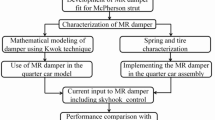Abstract
Background
The present study insights the development of magneto rheological (MR) damper and its comparison with existing viscous damper. The advantage of a magneto rheological damper over an existing viscous damper or passive damper is that they offer semi-active control of the system. The magneto rheological damper with a little power produces a very quick response to the applied current in Ampere.
Purpose
As the existing viscous damper produces damping force proportional to the velocity of vibration, damping force is less at the low velocity of vibration. Semi-active suspensions provide the advantage of generating the required damping force at low velocities. To apply the theory of semi-active suspension, an MR damper was selected to generate the required damping force.
Methods
Both dampers are tested on a quarter car test rig and vibration amplitudes are obtained at different frequencies. A magneto rheological damper performance is compared with the existing conventional viscous damper by obtaining acceleration and displacement plots.
Results
It is observed that the passive damper generates a high acceleration of 5.492 m/s2 at 20 kg load and 1.33 Hz frequency. Whereas, with the help of MR damper, output acceleration of a passenger car can be reduced from 2.981 to 2.051 m/s2 at the same frequency. The output acceleration for a passenger car with MR damper is reduced by 46% as compared to a passive damper, thus resulting in better ride comfort.
Conclusion
From the experimental data, it is observed that the damping force of MR damper increases with the increase in the current and magnetic field. By changing the magnetic field, acceleration is significantly reduced at any applied excitation frequency of the system.









Similar content being viewed by others
References
International Standards Organization (1997) International standard mechanical vibration and shock – evaluation of human exposure to whole body vibration. 2nd ed., ISO 2631: Part 1, 1997-07-15
British Standard Institution (1987) British standard guide to measurement and evaluation of human exposure to whole body mechanical vibration and repeated shock. BS, pp 6841:1987
Fernandes ES, Sheth SS, Nawpute KK, Kadam VV, Mitra AC (2017) Optimization of vehicle suspension system to improve comfort. IOSR JMech Civ Eng 17(01):33–40. https://doi.org/10.9790/1684-17010013340
Mohankumar D, Sabarish R, Prem Jeya Kumar M (2018) Variable damping force shock absorber. Int J Pure Appl Math 118(18):945–955
Yerrawar RN, Arakerimath RR (2018) Experimental investigations of damping characteristic for MR strut by half-power bandwidth method. J Meas Eng 6(3):163–172. https://doi.org/10.21595/jme.2018.20122
Ma X, Wong PK, Zhao J (2019) Practical multiobjective control for automotive semi-active suspension system with nonlinear hydraulic adjustable damper. Mech Syst Signal Process. https://doi.org/10.1016/j.ymssp.2018.08.022
Desai RM, Jamadar MEH, Kumar H et al (2019) Evaluation of a commercial MR damper for application in semi-active suspension. Springer Nat Appl Sci. https://doi.org/10.1007/s42452-019-1026-y
Sun S, Yang J, Li W, Deng H, Du H, Alici G (2015) Development of a novel variable stiffness and damping magneto rheological fluid damper. Smart Mater Struct 24:085021
Kumaresh SA, Aladdin MF (2019) A study of vibration transmission on seated person in passenger vehicle. In: AIP Conference Proceedings, vol. 2137, no. 1, p. 040001, AIP Publishing LLC
Zhao J, Wong PK, Xie Z, Wei C, Zhao R (2016) Design and evaluation of a ride comfort based suspension system using an optimal stiffness determination method. Trans Can Soc Mech Eng 40(5):773–785
Rikaz M, Abeysinghe A, Perera M (2019) Review on vibration quality improvement of a passenger seat. Vibroeng Proc. https://doi.org/10.21595/vp.2019.20590
Jamadar M-H, Desai RM, Saini RST, Kumar H, Joladarashi S (2020) Dynamic analysis of a quarter car model with semi-active seat Suspension using a novel model for magneto rheological (MR) damper. J Vib Eng Technol. https://doi.org/10.1007/s42417-020-00218-1
Jayabalan A, Kumar NKS (2018) Vibration suppression of quarter car using sliding-mode and internal model-based skyhook controller. J Vib Eng Technol 6(2):117–126
Hong KS, Park S (2010) Road-frequency adaptive control for semi-active suspension systems. Int J Control Autom Syst 8(5):1029–1038
Guneyisi E, Gesoglu M, Naji N, Ipek S (2016) Evaluation of the rheological behavior of fresh self-compacting rubberized concrete by using the Herschel-Bulkley and modified Binghammodels. Arch Civ Mech Eng 16:9–19. https://doi.org/10.1016/j.acme.2015.09.003
Grover GK (1970) Mechanical vibrations, 7th edn. Nem Chand & Bros, Roorkee
Acknowledgements
The authors would like to express sincere thanks to the Principal of Shri Chhatrapati Shivaji Maharaj College of Engineering, Ahmednagar for proving Quarter car model experimental Test rig.
Author information
Authors and Affiliations
Corresponding author
Ethics declarations
Conflict of interest
The authors declare no conflict of interest.
Additional information
Publisher's Note
Springer Nature remains neutral with regard to jurisdictional claims in published maps and institutional affiliations.
Rights and permissions
About this article
Cite this article
Narwade, P., Deshmukh, R., Nagarkar, M. et al. Improvement of Ride Comfort in a Passenger Car Using Magneto Rheological (MR) Damper. J. Vib. Eng. Technol. 10, 2669–2676 (2022). https://doi.org/10.1007/s42417-022-00512-0
Received:
Revised:
Accepted:
Published:
Issue Date:
DOI: https://doi.org/10.1007/s42417-022-00512-0




